Camden Town Hall Annexe, a 1970s concrete-framed extension to the main town hall building, is currently being transformed by McLaren Construction from an eight-storey council office block into an 11-storey, 270-room hotel for developer Crosstree.
The project has involved complex temporary works and structural remodelling, a task undertaken by specialist subcontractor Construction Solutions, headquartered in Harrow. This work has included strengthening the building to enable the addition of three storeys, the removal of two cores, creation of a new goods lift shaft and provision of a curved ‘scenic lift’ on the external Euston Road elevation, maximising views of St Pancras Station on the other side of the road.
Not only has the programme required meticulous sequencing of temporary works, demolition and structural alterations, it has also been carried out on a confined site surrounded by busy roads while the adjoining Camden Town Hall building has remained fully occupied and in public use throughout.
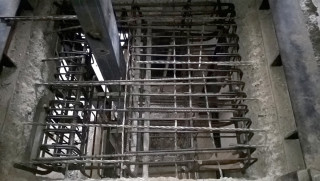
One of the first elements of the structural and temporary works package was to erect the site’s tower crane.
Construction Solutions excavated a pit in the basement to expose the caps of the reinforced concrete piles that had been installed specifically to support the crane. Reinforcement was then fixed over the pile caps and the yellow steel crane stillage was positioned and a concrete slab cast over the rebar to secure the crane foundations.
The tower crane was then assembled in sections. The Construction Solutions team will return to site to break out the crane base when it is no longer required on site, demolishing the temporary crane foundations and reinstating the slab.
Construction Solutions worked closely with the project’s structural engineer Heyne Tillet Steel (HTS) throughout the programme to ensure that the works on site accurately reflected the loading calculations and demolition tolerances for the building.
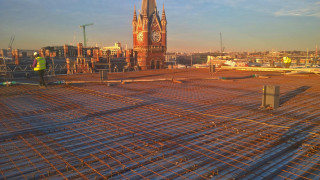
“HTS designed the temporary works and, utilising these designs, we carried out a thorough survey of the building, including ferro-scanning of each slab to ascertain the exact location of every piece of rebar,” says Construction Solutions’ project manager Andy Barrons.
The amount of steel rebar that could be removed during the alterations was precisely calculated and Construction Solutions had to make certain that cutting equipment did not damage or destroy any existing reinforcement that was structurally critical.
The first temporary works installation was the supporting steelwork which rises from sub-basement level to the underside of level eight. Custom-fabricated temporary steelwork was installed to support the structure while large areas of the floor slabs were removed.
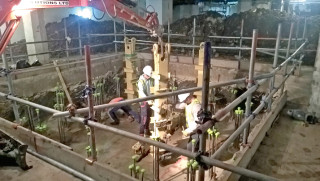
With the temporary steelwork in place, voids could be created for permanent steel columns, which are precisely positioned in ten locations around the internal perimeter of the existing structure, rising from the transfer slab on the first floor up the full height of the existing building.
“These columns will increase the load-bearing capacity of the existing structure to enable the addition of the three new storeys,” explains Barrons.

Once the steel columns had been positioned, additional rebar was added and fresh concrete was cast back around the columns to reinstate the slab.
With the columns and the temporary steelwork in place, Construction Solutions was able to excavate the new core for the goods lift. Once again, this had to be carried out with minimal removal of the existing rebar. “There was zero tolerance for any damage to the reinforcement within the 1,200mm-thick first-floor transfer beam which is critical to the structural integrity of the whole building,” says Barrons.
The area where the 1970s annexe narrows to connect with the older Camden Town Hall building is known by the project team as the ‘neck’. Here, the two redundant cores were removed.
In order to take out the two cores without jeopardising the structural integrity of the building, a void was created for a shear wall to be built within the existing structure, positioned adjacent to the neck of the building.
Rising from sub-basement level to the under-side of level four, the shear wall will ensure the core stability of the building and has been formed as a substantial reinforced concrete structure, requiring stitch drilling of the first floor transfer beam – once again without drilling into any of the existing rebar.
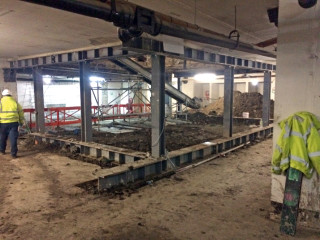
The loading requirements for the additional storeys were such that both the new lift core and the shear wall had to be completed and cured to full strength before erection of the steelwork could begin on the new storeys. Following close collaboration with the concrete supplier, Construction Solutions changed the specification to a suitable self-compacting concrete that would allow monolithic construction of the strengthening slabs while offering the required strength.
Preparation for construction of the new three-storey extension also involved demolition of the original 700m2 plant room. To overcome the need for traditional decking methods, a detailed overlapping plate system was introduced with back-propping to allow demolition of the structure.
A Brokk remote-controlled demolition robot from Construction Solutions’ own in-house plant fleet was used to enable the site team to stand back from the work area in complete safety while the machine broke out the concrete.
Once the rooftop demolition had been completed, a new slab could be cast to enable construction of the additional storeys.
Here again, the speed and efficiency of the Construction Solutions team in installing the steel reinforcement and casting the new slab was programme-critical, as construction of the additional storeys could not begin until these works had been completed and the concrete had cured to full strength.
Throughout the complex programme, the McLaren and Construction Solutions teams have taken a proactive, problem-solving approach to managing the challenges of the scheme which is scheduled for completion later this year.
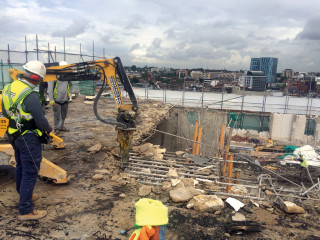
This article was first published in the May 2018 issue of The Construction Index magazine, which you can read for free at http://epublishing.theconstructionindex.co.uk/magazine/may2018/
UK readers can have their own copy of the magazine, in real paper, posted through their letterbox each month by taking out an annual subscription for just £50 a year. See www.theconstructionindex.co.uk/magazine for details.
Got a story? Email news@theconstructionindex.co.uk


